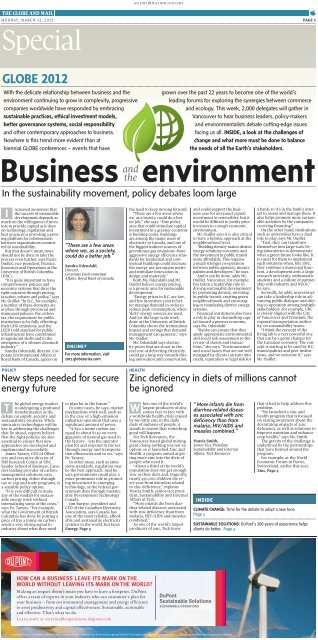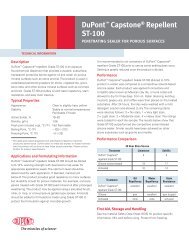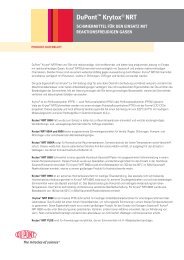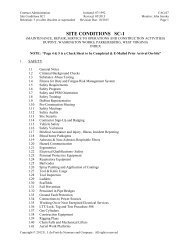"The Globe and Mail" (PDF) - DuPont
"The Globe and Mail" (PDF) - DuPont
"The Globe and Mail" (PDF) - DuPont
Create successful ePaper yourself
Turn your PDF publications into a flip-book with our unique Google optimized e-Paper software.
AN INFORMATION FEATUREMONDAY, MARCH 12, 2012 PAGE 1SpecialGLOBE 2012With the delicate relationship between business <strong>and</strong> theenvironment continuing to grow in complexity, progressivecompanies worldwide have responded by embracingsustainable practices, ethical investment models,better governance systems, social responsibility<strong>and</strong> other contemporary approaches to business.Nowhere is this trend more evident than atbiennial GLOBE conferences – events that havegrown over the past 22 years to become one of the world’sleading forums for exploring the synergies between commerce<strong>and</strong> ecology. This week, 2,000 delegates will gather inVancouver to hear business leaders, policy-makers<strong>and</strong> environmentalists debate cutting-edge issuesfacing us all. INSIDE, a look at the challenges ofchange <strong>and</strong> what more must be done to balancethe needs of all the Earth’s stakeholders.Business environment<strong>and</strong>theIn the sustainability movement, policy debates loom largencreased awareness thatthe success of sustainabledevelopment depends asmuch on the willingness of investorsto provide capital as it doeson technology, regulation <strong>and</strong>best practices is providing a growingplatform for collaborationbetween organizations committedto sustainability.But that doesn’t mean moreshould not be done to take theprocess even further, says PierreOuillet, vice-president, Finance,Resources <strong>and</strong> Operations at theUniversity of British Columbia(UBC).“It is quite important to havecomprehensive policies <strong>and</strong>incentive systems that drive theright outcome through pricing,taxation, rebates <strong>and</strong> policy,” saysMr. Ouillet. “In B.C., for example,a number of these elements arein place through provincial <strong>and</strong>municipal policies: the carbontax, the requirement for publicinstitutions to be fully offsettingtheir GHG emissions, <strong>and</strong> theLEED Gold st<strong>and</strong>ard for publicinfrastructure have contributedto significant shifts <strong>and</strong> to theemergence of a vibrant cleantechindustry.”S<strong>and</strong>ra Odendahl, director, CorporateEnvironmental Affairs atRoyal Bank of Canada, agrees on“<strong>The</strong>re are a few areaswhere we, as a society,could do a better job.”S<strong>and</strong>ra Odendahl,Director,Corporate EnvironmentalAffairs, Royal Bank of CanadaONLINE?For more information, visit2012.globeseries.com.the need to keep moving forward.“<strong>The</strong>re are a few areas wherewe, as a society, could do a betterjob,” she says. “One policyarea that could stimulate capitalinvestment in a greener economyis building codes. Buildingsare among the major users ofelectricity in Canada, <strong>and</strong> one ofthe biggest indirect sources ofgreenhouse gas emissions. Moreaggressive energy efficiency st<strong>and</strong>ardsfor residential <strong>and</strong> commercialbuildings could decreasethe energy use per square metre<strong>and</strong> stimulate innovation indesign <strong>and</strong> materials.”Both Ms. Odendahl <strong>and</strong> Mr.Ouillet believe energy pricingis a priority area for sustainabledevelopment.“Energy prices in B.C. are low,<strong>and</strong> few incentives exist to bettermanage dem<strong>and</strong> in order toreduce peak consumption, when‘dirty’ energy sources are used.And yet the large-scale workdone at the University of BritishColumbia shows the tremendousimpact <strong>and</strong> savings that dem<strong>and</strong>management can generate,” saysMr. Ouillet.Ms. Odendahl says electricityprices that are closer to thereal cost of delivering electricitycould go a long way towards drivinginnovation <strong>and</strong> conservation,<strong>and</strong> could support the businesscase for increased capitalinvestment in renewables, but itwould be difficult to justify priceincreases in a tough economicenvironment.Mr. Ouillet says it is also criticalto have a holistic approach at theneighbourhood level.“Building density makes districtenergy solutions economic <strong>and</strong>the investment in public transitmore affordable. This requiresa much stronger co-operationbetween public agencies, municipalities<strong>and</strong> developers,” he says.And it can be done, adds Mr.Ouillet. Vancouver, for example,has taken a leadership role indriving sustainable developmentby promoting density, investingin public transit, creating greenneighbourhoods <strong>and</strong> encouragingor m<strong>and</strong>ating district energysystems.Financial institutions also havea role to play in channelling capitaltoward a greener economy,says Ms. Odendahl.“Banks can ensure that theyapply appropriate environmental<strong>and</strong> social risk assessment to thereview of clients <strong>and</strong> transactions,”she says. “Environmental<strong>and</strong> social issues that are not wellmanaged by clients can turn intocredit, reputation or legal risk fora bank, so it’s in the bank’s interestto assess <strong>and</strong> manage these. Italso helps promote more sustainableactivities by the companiesreceiving financing.”On the other h<strong>and</strong>, institutionssuch as universities have a dualrole to play, says Mr. Ouillet.“First, they can transformthemselves into large-scale livinglaboratories to demonstratewhat a green future looks like. Itis easier for them to implementsuch solutions when, like UBC,they combine a municipal function,a development arm, a largeresearch university, enthusiasticstudents <strong>and</strong> a culture of partnershipwith industry <strong>and</strong> NGOs,”he says.Secondly, he adds, universitiescan take a leadership role in advancingpublic dialogue <strong>and</strong> drivingco-operation among multiplestakeholders. For example, UBCis closely aligned with the Cityof Vancouver <strong>and</strong> Translink, theregional transportation authority,on sustainability issues.“I think the concept of theliving lab is a very powerful onethat can be a game changer forthe Canadian economy. <strong>The</strong> conceptis starting to be used by B.C.municipalities <strong>and</strong> peer institutions,<strong>and</strong> we welcome it,” saysMr. Ouillet.POLICYNew steps needed for secureenergy futureHEALTHZinc deficiency in diets of millions cannotbe ignoredhe global energy marketis undergoing a profoundtransformation as thedebate on supply, security <strong>and</strong>sustainability escalates. Whileinnovative technologies will bekey to addressing the challengesthat lie ahead, experts believethat the right policies are alsoessential to ensure that newapproaches are developed <strong>and</strong>implemented successfully.James Tansey, CEO of Offsetters<strong>and</strong> executive director ofISIS Research Centre at UBCSauder School of Business, Canada’sleading provider of carbonmanagementsolutions, sayscarbon pricing, either throughtax or cap <strong>and</strong> trade programs, isa sensible policy option.“It is very difficult to makeany of the models for sustainableenergy work withoutinternalizing some of the costs,”says Dr. Tansey. “For example,what the Government of BritishColumbia has done by putting aprice of $30 a tonne on carbonsends a very strong signal toindustry about what they needto plan for in the future.”In some cases, he says, marketmechanisms work well, such asin the case of a high-emissionindustrial operation that uses asignificant amount of power.“A $30 a tonne carbon tax –equal to about $1.50 on everygigajoule of natural gas used inthe factory – lets the operatorplan for <strong>and</strong> respond to the taxthrough energy <strong>and</strong> transportationefficiencies <strong>and</strong> so on,” saysDr. Tansey.In other areas, such as emissionsst<strong>and</strong>ards, regulation maybe the best approach. And hesays governments could play amore prominent role in promotinginvestment in emergingtechnology, as the federal governmentdoes through SustainableDevelopment TechnologyCanada.Jim Burpee, president <strong>and</strong>CEO of the Canadian ElectricityAssociation, says Canada hasone of the most reliable, affordable<strong>and</strong> sustainable electricitysystems in the world, but facesEnergy, Page 4hen one of the world’slargest producers of zinccomes face to face witha worldwide health crisis causedby too little zinc in the dailydiets of millions of people, itst<strong>and</strong>s to reason that somethinggood will happen.For Teck Resources, theVancouver-based global mininggiant, doing nothing was not anoption, so it launched Zinc <strong>and</strong>Health, a program aimed at gettingmore zinc into the diets ofpeople who need it.“About a third of the world’spopulation does not get enoughzinc in their diets <strong>and</strong>, tragically,nearly 450,000 children die everyyear from disorders relatedto zinc deficiency,” explainsMarcia Smith, senior vice president,Sustainability <strong>and</strong> ExternalAffairs at Teck.“More infants die from diarrhea-relateddiseases associatedwith zinc deficiency than frommalaria, HIV/AIDS <strong>and</strong> measlescombined.”As one of the world’s largestproducers of zinc, Teck knew“ More infants die fromdiarrhea-related diseasesassociated with zincdeficiency than frommalaria, HIV/AIDS <strong>and</strong>measles combined.”Marcia Smith,Senior Vice President,Sustainability <strong>and</strong> ExternalAffairs, Teck ResourcesINSIDEthat it had to help address thisproblem.“We launched a zinc <strong>and</strong>health program that is focusedon raising awareness about thedevastating impacts of zincdeficiency, as well as solutions toimprove nutrition <strong>and</strong> enhancecrop health,” says Ms. Smith.<strong>The</strong> gravity of the challenge isunderlined by the partnershipsthat have formed around theprogram.For example, at the WorldEconomic Forum in Davos,Switzerl<strong>and</strong>, earlier this year,Zinc, Page 4CLIMATE CHANGE: Time for the debate to adopt a new tone.Page 3SUSTAINABLE SOLUTIONS: <strong>DuPont</strong>’s 200 years of experience helpsclients do better. Page 4HOW CAN A BUSINESS LEAVE ITS MARK ON THEWORLD WITHOUT LEAVING ITS MARK ON THE WORLD?Making an impact doesn’t mean you have to leave a footprint. <strong>DuPont</strong>offers a team of experts in your industry who can customize a plan foryour business – from environmental management <strong>and</strong> energy efficiencyto asset productivity <strong>and</strong> capital effectiveness. Sustainable, actionable<strong>and</strong> effective. That’s what we do.Learn more at sustainableoperations.dupont.com<strong>DuPont</strong>Sustainable SolutionsSUSTAINABLE OPERATIONSCopyright © 2012 E. I. du Pont de Nemours <strong>and</strong> Company. All rights reserved. <strong>The</strong> <strong>DuPont</strong> Oval Logo <strong>and</strong> <strong>DuPont</strong> are registered trademarks or trademarks of E. I. du Pont de Nemours <strong>and</strong> Company or its affiliates.
the g lobe <strong>and</strong> mail • mondaY, ma rc h 12, 2012AN INFORMATION FEATURE • page 2GLOBE 2012SUSTAINABLE CITIESCities must cope with growing global urbanizationCities of the future must balance l<strong>and</strong> use <strong>and</strong> residential development to ensure that they are sustainable <strong>and</strong> provide for the needs of their residents.PHOTOS: SUPPLIEDmagine the world’s currenttotal population– seven billion people– all living in cities, makingunprecedented dem<strong>and</strong>s on theresources required to supporturban existence. Will we cope,or will society collapse under itsown unsustainable weight?David Boyd, adjunct professor,Resource <strong>and</strong> EnvironmentalManagement at Simon FraserUniversity, <strong>and</strong> co-chair of Vancouver’sGreenest City ActionTeam, along with Mayor GregorRobertson, says we will get theanswer by 2050. That’s whenforecasters believe seven billionpeople will be living in citiesaround the world.Dr. Boyd sees this massivemove to urban centres as both achallenge <strong>and</strong> an opportunity.“If we succeed in making citiessustainable, then we will achievethe holy grail of a sustainablefuture for humankind,” he says.And it’s not just the mega-citiesin developing countries thatface the challenge of sustainability.Right here in Canada, we needto do far more, warns Dr. Boyd.“Canadian cities are saddledwith unsustainable transportationsystems, outdated water <strong>and</strong>wastewater infrastructure, <strong>and</strong>inefficient buildings. <strong>The</strong>se arelegacies of an era when cornucopianfantasies <strong>and</strong> the automobiledominated urban design,”he says.Another huge challenge, headds, is that Canadian cities arestruggling towards sustainabilitywith one arm tied behind theirbacks, because of inadequaterevenue-raising powers <strong>and</strong>counterproductive federal <strong>and</strong>provincial policies.And that’s a big part of theproblem as noted in a recentFederation of Canadian Municipalitiesreport, Building Canada’sGreen Economy.<strong>The</strong> report’s co-author is DavidThompson, director of sustainablecommunities at Ottawabasedthink-tank SustainableProsperity.“Normal municipal policytools – planning, zoning <strong>and</strong>the like – tend to focus on thesymptoms without tacklingthe cause: prices. <strong>The</strong> bottomline is that buying on the urbanfringe is cheaper than buying inestablished urban areas. As theysay in the mortgage business,‘drive until you qualify,’” says Mr.Thompson.He points out that the costsof sprawling development areartificially suppressed by a rangeof financial <strong>and</strong> non-financialsubsidies such as the sprawlinducingincentives embeddedin the structure of municipal revenueinstruments like propertytaxes <strong>and</strong> property developmentcharges, in subsidies for infrastructure<strong>and</strong> services, <strong>and</strong> inunpaid environmental costs thateconomists term externalities.“Prices are very powerful decisiondrivers,” says Mr. Thompson.“<strong>The</strong> good news is we canshift the incentives at no net costto the city, <strong>and</strong> make them rewarddenser development. And ifwe really want to beat sprawl, weneed to get the prices right.”And sustainable cities not onlyprotect the environment, theyalso provide proven health <strong>and</strong>lifestyle benefits to residents.“Researchers have long known“European cities such asCopenhagen <strong>and</strong> Stockholmoffer invaluablelessons about greeninfrastructure <strong>and</strong> makingpeople the priority.One of the fundamentallessons involves reallocatingpublic spacefrom cars to people.”David Boyd,Adjunct Professor, Resource <strong>and</strong>Environmental Management,Simon Fraser Universitythat suburban sprawl locks inautomobile dependency, guaranteeingdecades of higher climatechange <strong>and</strong> smog emissions,”says Mr. Thompson. “Currentresearch is revealing an associationbetween urban sprawl <strong>and</strong>obesity, depression, diabetes <strong>and</strong>other illnesses.”Mr. Boyd says a sustainablecity is a place where people canhappily live, work, play, raisetheir children <strong>and</strong> retire.“It’s a place where all residentsenjoy clean air, safe water,comfortable housing, the musicof songbirds <strong>and</strong> access to greenspaces within a five-minutewalk,” he says. “A place wherethe average ecological footprintis within Earth’s capacity.”While it may seem utopian, Mr.Boyd says real progress is beingmade towards sustainable cities.“Urban visionaries <strong>and</strong> plannersunderst<strong>and</strong> that we livein a world of limits. Bigger isnot always better, <strong>and</strong> there aresmarter approaches. Europeancities such as Copenhagen <strong>and</strong>Stockholm offer invaluable lessonsabout green infrastructure<strong>and</strong> making people the priority.One of the fundamental lessonsinvolves re-allocating publicspace from cars to people,” saysMr. Boyd.Here at home, he adds,Vancouver is a model forother Canadian cities because itscutting-edge sustainability planis focused on action.“From district energy systems<strong>and</strong> city-wide composting toseparated bike lanes <strong>and</strong> communitygardens, Vancouver isundergoing both visible <strong>and</strong>invisible transformations in itsquest for global leadership.”Mr. Boyd says Vancouver’ssuccess proves that aggressiveaction to become a sustainablecity triggers a virtuous circle:attracting human <strong>and</strong> financialcapital that leads to green jobs,healthier people, more happiness<strong>and</strong> smaller ecologicalfootprints.“It demonstrates that theEuropean approach can work inNorth America,” he says.This report was produced by R<strong>and</strong>allAnthony Communications Inc. (www.r<strong>and</strong>allanthony.com) in conjunction with the advertising department of <strong>The</strong> <strong>Globe</strong> <strong>and</strong> Mail. Richard Deacon, National Business Development Manager, rdeacon@globe<strong>and</strong>mail.com.We see the possibilities.As a responsible energy developer, Suncor Energy faces an important challenge every day: to provide energy in a way thatminimizes our environmental impact. Our renewable energy team is working on part of the solution. Using revenues fromoil s<strong>and</strong>s development, their job is to develop projects that offset greenhouse gas emissions while creating significant newbusiness opportunities. <strong>The</strong>ir track record is impressive. Suncor is an owner in six operating wind projects <strong>and</strong> we’re alsoone of the largest biofuels producers in the country. Seeing the possibilities of renewable energy is a key component of ourstrategy <strong>and</strong> helps us build a more sustainable future.$750millionactual<strong>and</strong> planned investmentsin renewable energyby 20121million tonnes of CO 2emissions avoided per yearthrough Suncor’s renewableenergy portfolio255megawattsof electricityproduced by Suncor’s sixwind farms, enough to powerabout 100,000 homesFind out more about Suncor’s track record <strong>and</strong> how we are planning to responsibly develop North America’s energy supply.www.suncor.com/sustainabilityJudith Athaide, Kolja Vainstein,Dianne Zimmerman <strong>and</strong>Kip Clancy work on Suncorrenewable energy projectsperformancepartnershipspossibilities Trademark of Suncor Energy Inc.
the globe <strong>and</strong> mail • mondaY, march 12, 2012AN INFORMATION FEATURE • page 4GLOBE 2012DUPONT SUSTAINABLE SOLUTIONS<strong>DuPont</strong> helping others to achieve sustainabilityn the 210 years since itwas founded in 1802,<strong>DuPont</strong> has learned a lotabout the best way to managea complex business. So it madesense to turn that experienceinto a service to help other organizations.As one of the world’s leadingscience companies, <strong>DuPont</strong>’sproducts <strong>and</strong> services havetouched the lives of billions ofpeople over many generations.But it has also faced significantchallenges <strong>and</strong> learned valuablelessons in addressing them.In the 1970s <strong>and</strong> 1980s,<strong>DuPont</strong>’s focus was on internalsafety <strong>and</strong> meeting environmentalregulations.In the late 1980s, Ed Woolard,chairman <strong>and</strong> CEO at the time,decided that it was essential to gofurther to address the challengesfacing the company. With theyear 2000 as the deadline, hecommitted <strong>DuPont</strong> to a numberof voluntary environmentalcommitments, including cuttingtoxic air emissions by 75 per cent,air carcinogens by 92 per cent,greenhouse gas emissions by 40per cent <strong>and</strong> hazardous waste by46 per cent.<strong>DuPont</strong> looked to increaseshareholder value with a goalof zero injuries, illnesses <strong>and</strong>environmental incidents as itdecreased raw material <strong>and</strong> energyinputs into its products <strong>and</strong>reduced emissions at its manufacturingsites.Neither Mr. Woolard noranyone else in the organizationknew exactly how it would bedone, but they were determinedto do it – <strong>and</strong> by 2000 had exceededall the voluntary commitments.Today, <strong>DuPont</strong> strives to buildsustainability into every productit develops, says Jim Weig<strong>and</strong>,president of <strong>DuPont</strong> SustainableSolutions (DSS), the divisionwithin the company that providesenvironmental, safety <strong>and</strong>process management consultingservices to other organizations.“Mr. Woolard’s successors,Chad Holliday <strong>and</strong> then EllenKullman, our current chairman<strong>and</strong> CEO, believed it was importantfor <strong>DuPont</strong> to use our experienceto help other companiesbecome more sustainable,” saysMr. Weig<strong>and</strong>.While DSS focused initially onworker safety, its service offeringhas since been exp<strong>and</strong>ed to sustainableoperations, environmentalplanning <strong>and</strong> process safety.Mr. Weig<strong>and</strong> says the globalfinancial crisis three years agomade many companies realizethat while safety remainedimportant, they also needed tomake better use of capital byimplementing sustainable operations.“By operationalizing sustainability,companies not onlyimprove their safety records, butalso their overall performance onthe triple bottom line – people,profits, planet,” he adds.Suncor Energy, one of theleading operators in the oil s<strong>and</strong>s,has been working with DSSfor more than five years. GordLambert, Suncor’s vice presidentof sustainable development, saysDSS was a logical choice for thecompany.“<strong>DuPont</strong> <strong>and</strong> the rest of thechemical industry transformeditself in the 1980s <strong>and</strong> 1990s, <strong>and</strong>that journey is similar to whatthe oil s<strong>and</strong>s industry has to takeon. We have to drive efficiency“By operationalizingsustainability, companiesnot only improvetheir safety records,but also their overallperformance on thetriple bottom line –people, profits, planet.”Jim Weig<strong>and</strong>,President, <strong>DuPont</strong> SustainableSolutions<strong>and</strong> reduce our environmentalfootprint,” says Mr. Lambert.Currently, DSS is helpingSuncor with its environmentalgoals including l<strong>and</strong> reclamation,water use <strong>and</strong> air emissions byensuring that capital allocation isoptimized to achieve the biggestenvironmental impact possiblefor every dollar spent.And while DSS’s service offeringcontinues to evolve to meetclients’ needs, <strong>DuPont</strong> itself isdeveloping <strong>and</strong> implementing itsown new sustainable practicesthat can be passed on throughDSS.For example, says Mr. Weig<strong>and</strong>,between 2008 <strong>and</strong> 2011 <strong>DuPont</strong>’sBuilding Innovations businesseliminated 81 million pounds ofwaste that had been going intol<strong>and</strong>fills by reducing waste at thesource, recycling <strong>and</strong> turning theremainder of the waste into byproductsthat are now generatingrevenue for the company.“What we bring to clients isreal world experience; not juststrategies,” says Mr. Weig<strong>and</strong>.“Our recommendations are basedon what we have done <strong>and</strong> continueto do every day in <strong>DuPont</strong>.”FROM PAGE 1Energy: Action needed at government levela major challenge to renew,replace <strong>and</strong> exp<strong>and</strong> infrastructure.“<strong>The</strong> electricity system is thelifeblood of our economy,” saysMr. Burpee. “Changes in policies<strong>and</strong> legislation that createa clear <strong>and</strong> predictable regulatoryenvironment will allowthe $347 billion in investmentsplanned between now <strong>and</strong> 2030to be made efficiently, effectively<strong>and</strong> sustainably.”He believes governmentsacross the country have thecapacity to take a holistic, integratedapproach to energy regulationbased on the principlesof sustainable development.“While the electricity sector isworking toward fostering greaterpublic underst<strong>and</strong>ing <strong>and</strong>acceptance of electricity-relatedprojects, we need governmentsto work toward clearing the“Through investmentin a Canadian energyinnovation strategy,the government shouldconsider greater publicprivatepartnerships inresearch, development<strong>and</strong> the deployment ofnew technologies, use ofan innovation fund, loanguarantees <strong>and</strong> otherfinancial incentives.”Jim Burpee,President <strong>and</strong> CEO, CanadianElectricity Associationdecision path for infrastructureproject approvals. Specifically,this takes the form of reformingthe approvals process for largeinfrastructure projects. At thesame time, we need governmentsto work with the industryto build public support forneeded infrastructure investments,”says Mr. Burpee.At the federal level, governmenthas an important role toplay in supporting investmentsin infrastructure-related innovation,he adds.“Through investment in a Canadianenergy innovation strategy,the government shouldconsider greater public-privatepartnerships in research, development<strong>and</strong> the deployment ofnew technologies, use of an innovationfund, loan guarantees<strong>and</strong> other financial incentives,”says Mr. Burpee.He adds that the industry isalso concerned about loominglabour shortages.“A recent report releasedby the Conference Board ofCanada predicts that investmentactivity in the electricitysector will support an averageof 156,000 jobs per year until2030. But labour shortages willthreaten the reliability <strong>and</strong> sustainabilityof Canada’s futureelectricity supply,” warns Mr.Burpee.Health care professionals <strong>and</strong> female community health volunteers working toraise awareness about zinc deficiency in Nepal.PHOTO: COURTESY OF UNICEF AND THE INTERNATIONAL ZINC ASSOCIATIONFROM PAGE 1Zinc: Multi-party approach canhave an impactTeck <strong>and</strong> BASF, the world’sleading chemical company, announceda three-year agreementto jointly develop innovative <strong>and</strong>affordable zinc fortification <strong>and</strong>supplementation solutions withthe goal of reducing zinc deficiencyamong 100 million peoplein developing countries by 2015.<strong>The</strong> signing ceremony wasattended by United Nations SecretaryGeneral Ban Ki-Moon, whosaid the full engagement of manysectors <strong>and</strong> actors, including theprivate sector, is needed to breakthe links between poverty, foodinsecurity <strong>and</strong> malnutrition.And in Ottawa last summer,Teck, the federal government<strong>and</strong> the Micronutrient Initiative,an Ottawa-based internationalnot-for-profit organization thathelps the world’s most vulnerablepeople in developingcountries get the vitamins <strong>and</strong>minerals they need, announceda partnership to develop <strong>and</strong>sustain zinc treatment programsto help save children’s lives.Commenting at the time, VenkateshMannar, president of theMicronutrient Initiative, said theuse of zinc, in combination withoral rehydration therapy, to helpchildren recover from life-threateningdiarrhea is well-known,but the treatment is not beingused enough in countries thathave high numbers of childrendying.“This new partnershipprovides a huge boost to zincprogramming that will save children’slives,” he said.Ms. Smith says the challenge isnot to produce more zinc, but toget zinc into the diets of peoplesuffering from zinc deficiency.“This requires education, betterdistribution networks <strong>and</strong>greater awareness of the dangersof zinc deficiency. In fact, theamount of zinc required annuallyfor zinc supplements to treatall cases of zinc deficiency isless than two per cent of Teck’sproduction <strong>and</strong> less than 0.1 percent of global zinc production,”she says.For more information visitwww.zincsaveslives.com.WITHGREATERWEALTHCOMESGREATERGOODCANADA’S LEADER INSOCIALLY RESPONSIBLEINVESTING.Evidenceshowsthatsociallyresponsiblecompaniesdobetterinthelongrun.Forthepast 25 years we’ve been actively engagingwithcompaniestohelpthemmitigateriskthroughsociallyresponsiblepractices.Thiscontributestobetterreturnsforyourportfoliowhile influencing positive change in the world.In 2012, we will engage with more than50 companies held in our funds to advancesustainable business practices. Companieslike Goldcorp. Following a visit to their MarlinMine in Guatemala in February 2008, wefiled a shareholder proposal asking Goldcorpto perform a Human Rights Impact Assessmenton their mine operations. As a result, Goldcorpnowmakesrespectforhumanrightsanexplicit component in their business strategy<strong>and</strong> operations.Ethical Funds offers the most comprehensivefamilyofsociallyresponsiblemutualfundsinCanada. Find out which ones are rightforyou.Ask your advisor about Ethical Funds today.MAKE MONEY.MAKE A DIFFERENCE.ETHICALFUNDS.COMCommissions, trailing commissions, management fees, <strong>and</strong> expenses all may be associated with mutualfund investments. Please read the prospectus before investing. Mutual funds are not guaranteed,their values change frequently <strong>and</strong> past performance may not be repeated. Ethical Funds <strong>and</strong> NEIInvestments are registered marks <strong>and</strong> trademarks owned by Northwest & Ethical Investments L.P.

















